Kalpesh V Vaghela*  and Shalibhadra V Shah
and Shalibhadra V Shah
Department of Pathology, Zydus medical college, and hospital, Dahod, Gujarat, India
Corresponding Author E-mail: drvaghs007@gmail.com
DOI : https://dx.doi.org/10.13005/bpj/2449
Abstract
Introduction When it comes to blood transfusion and transplant medicine, the ABO as well as Rh blood group system are significant. There have been 700 RBC antigens found so far, and they've been divided into 30 blood groups as a result. For example, blood transfusion reaction, paternity testing, legal medicine, as well as associations with different illnesses are all medicolegally relevant when looking at ABO and Rh. Aim: The objective was to find out how much demand there is for a specific blood type compared to how much supply there is in society, to lower death rates caused by a shortage of that kind of blood. Compare the results with those from another comparable research performed in India and across the globe. Material and Methods: Between August 2018 to July 2021, researchers conducted a study on 7820 blood donors who visited the Zydus blood Centre. Tube agglutination testing and the Gel card method were used to find the patient's ABO as well as Rh blood groups. Both reverse as well as forward blood grouping methods are performed and confirmed only if both are identical. The age and sex groups as well as frequency of ABO and Rh blood groups were reported in percentages. Result The male-to-female ratio in our research was 30:1. The greatest number of male and female donors were between the ages of 18 to 30 years. For blood donation, it has been found that "O" blood donors are the most predominant, then those with B>A>AB blood groups. According to voluntary and replacement blood donors, AB & A blood groups are more (%) in replacement blood donors as compare to O and B blood groups. Voluntary donors are 33.67% and replacement donors were 66.64%. Distribution of Rh+ve and Rh-ve blood groups in our study was 98.78% and 1.22% respectively. Conclusion It is essential to have a thorough understanding of the distinct blood groups distribution for ensuring that blood as well as its components are always available to recipients in a particular area. The present work will provide insight on a deficiency of particular blood groups, in a particular area, like A and AB blood group are more in replacement donor showing deficiency of that blood groups in this area in our study.
Keywords
ABO and Rh; Blood Transfusion; Donors; Demand; Dahod; supply ratio
Download this article as:| Copy the following to cite this article: Vaghela K. V, Shah S. V. Distribution of ABO And Rh Blood Groups in Blood Donors at the Tertiary Care Centre, Dahod. Biomed Pharmacol J 2022;15(2). |
| Copy the following to cite this URL: Vaghela K. V, Shah S. V. Distribution of ABO And Rh Blood Groups in Blood Donors at the Tertiary Care Centre, Dahod. Biomed Pharmacol J 2022;15(2).Available from: https://bit.ly/3LghL8J |
Introduction
The 1st human blood group system, “ABO” was discovered by Karl Landsteiner when he was at the University of Munich. He discovered 3 distinct types of blood, which he called A, B, & O, and was awarded the Noble Prize for his work 1,2. In 1902, the fourth kind of AB has been identified by Alfred Von Decastello & Adriano Sturli 3. The “International Society of Blood Transfusion” describes and organizes over 700 erythrocyte antigens into 30 blood group systems, including Rh & ABO 4. ABO gene is codominant in expression. A, B, or O genes occupy one of the 9 chromosomes that include it 5,6,7. Von Dungern described in 1911 how anti-A and antiA1 antigens react with group A RBCs. The former is classified as A1, while the latter is known as A2 8,9. The ABO & Rh blood type systems are critical in blood transfusion practice. ABO & D antigens can trigger a strong immune response and cause the destruction of red cells. They are also important for organ transplantation.
“Even today, transfusion of the wrong ABO group remains a cause of death in hemolytic transfusion reaction fatalities reported to the FDA; however, transfusion-related acute lung injury (TRALI) was the most frequent cause of death in fiscal year (FY) 2015” 10.
Good knowledge and understanding of blood grouping have an imperative involvement in the management of blood bank inventory. It can help to minimize the morbidity and mortality rate due to lack of blood in a particular geographical area 11,12 . The knowledge of blood groups can also be used in various studies related to genetic diseases which is more commonly associated with a particular type of blood group.
The objective was to find out how much demand there is for a specific blood type compared to how much supply there is in society, to lower death rates caused by a shortage of that kind of blood. Compare the results with those from another comparable research performed in India and across the globe.
Material and Methods
After getting clearance from our local ethical committee, the retrospective analysis has been performed in the blood bank of “Zydus Medical College & Hospital”, Dahod. The study period of this study was 3 years from August 2018 to July 2021. Blood from blood donors was collected in our blood centre and camp organized by different NGOs. All inclusion and exclusion criteria as per GSCBT, NBTC and NACO guidelines. After collection from blood donors, blood grouping was performed by slide techniques using commercially available standard antisera (Tulip diag. Pvt.) in which only forward grouping was performed (for screening purposes). Later on, in the blood centre both forward and reverse grouping methods were performed using Gel card technology. Blood group identification could only be verified if the forward and reverse groups were the same. Quality control for both antisera and Gel cards were performed every day and recorded in the register. All negative donors were confirmed by due test using gel card technology. Donor’s sex, age, date, donation location, medical history, and blood group ABO and Rh were tabulated in registers. The data were embedded in the MS office excel sheet. All the variables (blood groups and blood donors) were summarised as proportions and frequencies with percentages.
Results
In all, there were 7820 blood donors, with 7568 (96.77 %) being men and 252 (3.23 %) being women, and women donors are more in numbers in voluntary donors 165 as compared to replacement donors 87. Voluntary and replacement donors were 2609(33.67%) and 5211(64.63%) respectively (Table-1, Figure-1&2). According to blood groups, the highest number of donors from the O blood group (32.91%) was correspondingly followed by B(29.76), A(28.76%) & AB(8.59%). Voluntary: Replacement donors’ ratio is more in blood groups of AB and A in comparison to blood groups of B & O (Table-2, Figure-3). The total numbers of blood donors with Rh-positive were 7725(98.78%) whereas Rh-negative 95(1.22%)(Table-4, Figure-5).
Table 1: Distribution of Voluntary & replacement donors with respect to gender.
| Donors | Voluntary | Replacement | Total |
| Male | 2444 | 5124 | 7568(96.77%) |
| Female | 165 | 87 | 252(3.23%) |
| Total | 2609(33.67%) | 5211(64.63%) | 7820(100%) |
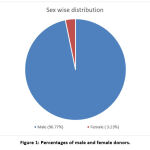 |
Figure 1: Percentages of male and female donors. |
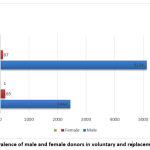 |
Figure 2: Prevalence of male and female donors in voluntary and replacement donation. |
Table 2: Comparison of voluntary and replacement blood donors according to blood groups.
| Blood groups | A | B | O | AB |
| Voluntary | 645(28.68%) | 870(37.40) | 900(34.98) | 194(28.87) |
| Replacement | 1604(71.32%) | 1456(6260) | 1673(62.02) | 478(71.13) |
| Total | 2249(28.76%) | 2326(29.76) | 2573(32.91%) | 672(8.59%) |
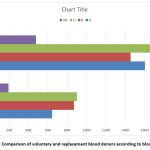 |
Figure 3: Comparison of voluntary and replacement blood donors according to blood groups. |
Similarly, there was replacement blood donors predominant as compared to voluntary donors in 18-30 years (3275, 41.88% vs 1531, 19.58%), 31-40 years (1476, 18.87% vs 718, 9.18%), 41-50 years (405, 5.18% vs 291, 3.73%) whereas in 51-65 years (80, 1.02% vs 44, 0.56%) voluntary donors are more in numbers. Age groups with the most donors were 18-30 years old 4806(61.46%), followed by 31-40 years 2194(28.06%), 41-50 years old 696(8.9%), and 51-65 years old 124(1.58%) (Table-3, Figure-4).
Table 3: Age-wise distribution of blood donors.
| Age(Years) | 18-30 | 31-40 | 41-50 | 51-65 | ||||
| Donors | Voluntary | Replacement | Voluntary | Replacement | Voluntary | Replacement | Voluntary | Replacement |
| No. | 1531 | 3275 | 718 | 1476 | 291 | 405 | 80 | 44 |
| % | 19.58 | 41.88 | 9.18 | 18.87 | 3.73 | 5.18 | 1.02 | 0.56 |
| Total | 4806(61.46%) | 2194(28.06%) | 696(8.9%) | 124(1.58%) | ||||
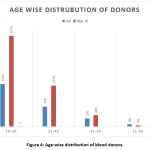 |
Figure 4: Age-wise distribution of blood donors. |
Table 4: Distribution of Rh Positive and Rh Negative Donors.
| Voluntary | Replacement | Total | Percentage | |
| Rh Positive | 2531 | 5194 | 7725 | 98.78% |
| Rh Negative | 78 | 17 | 95 | 1.22% |
| total | 2609 | 5211 | 7820 | 100% |
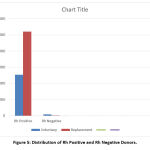 |
Figure 5: Distribution of Rh Positive and Rh Negative Donors. |
Table 5: Comparing frequency percentage of blood groups; Rh & ABO in distinct areas of India and around the globe.
| Sr.
No. |
India | Study Location | A | B | AB | O | Rh+ve | Rh-ve |
| 1. | Western India | Present analysis | 28.76 | 29.74 | 8.59 | 32.91 | 98.78 | 1.22 |
| 2. | Westen Ahmedabad [13] | 21.94 | 39.40 | 7.86 | 30.79 | 95.05 | 4.95 | |
| 3. | East- Ahmedabad [14] | 23.30 | 35.50 | 8.80 | 32.50 | 94.20 | 5.80 | |
| 4. | Northern India | Lucknow [15] | 21.73 | 39.84 | 9.33 | 29.10 | 95.71 | 4.29 |
| 5. | Amritsar [16] | 18.01 | 38.06 | 9.62 | 34.31 | 91.28 | 8.72 | |
| 6. | Central India | Maharashtra (Loni) [17] | 28.38 | 31.89 | 8.72 | 30.99 | 95.36 | 4.64 |
| 7. | East- India | Durgapur [18] | 23.90 | 33.60 | 7.70 | 34.80 | 94.70 | 5.30 |
| 8. | South- India | Shimoga-Malnad [19] | 24.27 | 29.43 | 7.13 | 39.17 | 94.93 | 5.07 |
| 9. | Devanagere [20] | 26.15 | 29.85 | 7.24 | 31.76 | 94.8 | 5.2 | |
| 10. | Bangalore [21] | 23.85 | 29.95 | 6.37 | 39.82 | 94.2 | 5.8 | |
| 11. | Except India | Pakistan(Swat) [22] | 27.92 | 32.40 | 10.58 | 29.10 | 90.13 | 9.87 |
| 12. | Nepal [23] | 34 | 29 | 4 | 33 | 96.7 | 3.3 | |
| 13. | Britain [24] | 42 | 8 | 3 | 47 | 83 | 17 | |
| 14. | United States [25] | 41 | 9 | 4 | 46 | 85 | 15 | |
| 15. | Australia [26] | 38 | 10 | 3 | 49 | NA | NA | |
| 16. | Nigeria [27] | 21.60 | 21.40 | 2.80 | 54.20 | 95.20 | 4.80 | |
| 17. | Saudi Arabia [28] | 24 | 17 | 4 | 52 | 93 | 7 |
Discussion
Male donors outnumber female donors in most Indian studies, according to the findings. Due to the cultural and social taboos, the number of female donors in developing countries like India was less. Also, many of them were declared unfit for blood donation due to malnourishment like low weight and low Hb due to multipara, repeated pregnancy, and menstruation during the pre-donation counseling. Overall blood donations in our area are less as compare to other regions due to most people are tribal, lack of inspiration for donating blood as well afraid of it. 18-30 years of age were the most common blood donors in every society in every region followed by 31-40 years of age groups. Less frequency from 51 -65 years blood donors due to suffering from hypertension, cardiac disease, diabetes and hence all these are deferred during pre-donation counseling.
Frequency distribution of ABO & Rh blood grouping within India also, outside India were compared in the table-4. Donors blood group study in western India region (Western Ahmedabad 13, Eastern Ahmedabad 14 show “B” group is most frequent followed by ‘O’ group were as our study show ‘O’ group is people more followed by ‘B’ group, rest blood group shows similar data in both studies. We observe that the ABO and Rh group distribution were comparable to the southern India region Shimoga-Malnad19 Devanagere 20 Bangalore 21) study. All studies show O>B>A>AB blood groups. “B” was the 2nd most prevalent blood type in this analysis which was similar to Durgapur 18 and southern India. Rh-positive donors are more and Rh-negative is less in this analysis were comparable to all other studies in India except Britain 24, USA 25 show high numbers of Rh-negative donors.
In our study show replacement donors 5211(64.63%) are more in number as compare to voluntary donors 2609(33.67%). Blood grouping-wise distribution of donors shows replacement donors were more frequent in ‘A’ 1604(71.32%) and ‘AB’ 478(71.13) blood groups as compared to ‘O’ 1673(62.02) and ‘B’ 1456(6260) blood groups. The above situation shows that demand for ‘A’ and ‘AB’ blood groups is more in our population as compared to ‘B’ and ‘O’ groups.
It also helps in the selection of donors for each region and the recruitment of voluntary donors for various purposes. This knowledge of blood groups can also be used in various studies related to population genetics, population migration patterns, medical procedures like disputed paternity, and disease prevention associated with different blood groups. The risk of CHD (“coronary heart disease”), atherosclerosis, ischemia, and venous thrombosis is higher in those with blood type “A”, according to research Blood type “O” individuals, on the other hand, are at a reduced risk 29,30. O group members had lower risks of squamous cell carcinoma, pancreatic as well as basal cell carcinoma than non-‘O’ group members 31,32,33. Ovarian cancer is more general in women who have blood type ‘B’ 34. Blood group ‘B’ shows the risk of gastric carcinoma and less with the ‘O’ group 35. As a result, a blood grouping study is crucial for ensuring that blood transfusion services are managed to their maximum potential. ABO and Rh typing are currently used for routine blood group testing, but there are some limitations to this method. To overcome these limitations, recent advances in RBC antigen genotyping using PCR-based methods such as next-generation sequencing (NGS) and high-density DNA microarray are now available36.
Conclusion
In our study male donors are more in comparison to female donors, the ratio of male-to-female in our research was 30:1, also the majority of the blood donors are between 18 and 30-years-age group. Blood groups: O>B>A>AB was identified to be more frequent in our research participants. Replacement donors are more as compared to voluntary donors and more deficiency of ‘A’ & ‘AB’ blood groups in the present analysis. So there needs to be awareness regarding blood donation, benefits, myths and encourage about voluntary donation for their society. Now a day blood group is mentioned on most identity cards like job cards, school cards, a driving license which play a crucial part during an emergency condition where blood is required. It must be mentioned on the Adhar card in our country which should help in many ways. Blood groups study will help in maintaining data at national health services. For RBC antigen genotyping, more emphasis will be placed on PCR-based newer technologies such as NGS and DNA microarray in the near future.
Acknowledgement
None.
Conflicts of Interest
Authors declare that they have no conflicts of interest regarding submitted article.
Funding Source
There is no any funding source.
References
- Garratty G, Dzik W, Issitt PD, Lublin DM, Reid ME, Zelinski T. Terminology for blood group antigens and genes-historical origins and guidelines in the new millennium. 2000;40:477–89. [PubMed: 10773062] CrossRef
- Mollison PL. The genetic basis of the Rh blood group system. Transfusion. 1994;34:539–41. [PubMed: 8023398] CrossRef
- Khurshid B, Naz M, Hassan M, Mabood SF. Frequency of ABO and Rh (D) blood groups in district Swabi, NWFP, Pakistan. J Sci Technol Univ Peshawar. 1992;16:5–6.
CrossRef - Table of blood group systems; International Society of Blood Transfusion (ISBT). Oct 2008, Available in http://ibgrl.blood.co.uk/isbt
- Klein HG, Anstee DJ. Mollison’s Blood Transfusion in Clinical Medicine. 12th ed. Somerset (NJ): Wiley-Blackwell Publishing; 2014.
CrossRef - Olsson ML, Chester MA. Polymorphism and recombination events at the ABO locus: a major challenge for genomic ABO blood grouping strategies. Transfus Med. 2001;11:295-313.
CrossRef - Chester MA, Olsson ML. The ABO blood group gene: a locus of considerable genetic diversity. Transfus Med Rev. 2001;15: 177-200.
CrossRef - Watkins WM. The ABO blood group system: historical background. Transfus Med. 2001;11:243-65.
CrossRef - Landsteiner K. Uber agglutinationserscheinungen normalen menschlichen blutes. Wien Klin Wschr. 1901;14:1132-4.
- S. Food and Drug Administration [Internet]. Silver Spring (MD): Fatalities reported to FDA following blood collection and transfusion: annual summary for fiscal year 2015. [Cited 2017 March 10]. Available from: www.fda.gov/BiologicsBloodVaccines/ SafetyAvailability/ReportaProblem/ TransfusionDonationFatalities/ ucm518148.pdf
- Behra R, Joshi YR. Distribution of ABO blood group and RH (D) factor in Western Rajasthan. Natl J Med Res. 2013;3:73–5. [Google Scholar]
- Eweidah MH, Rahiman S, Ali H, Dhas Al-Shamary AM. Distribution of ABO and Rhesus (RHD) blood groups in Al-Jouf province of the Saudi
- Patel Piyush A, Patel Sangeeta P, Shah Jigesh V, Oza Haren Frequency and distribution of blood groups in blood donors in western Ahmedabad – a hospital-based study. National J. Med. Res. 2012; 2(2):207-210.
- Wadhwa MK, Patel SM, Kothari DC, Pandey M, Patel Distribution of ABO and Rhesus-D groups in Gujarat, India: a hospital-based study. Indan J Ped Oncol.1998; 19 (4): 137–41.
- Chandra T, Gupta A. Frequency of ABO and rhesus blood groups in blood donors. Asian J Transfus Sci. 2012; 6:52-53.
CrossRef - Kaur H, Khanna A, Manjari M, Khanna M. Prevalence of ABO blood groups and rhesus (Rh) factor in the population residing in and around Amritsar, Punjab (a 4-year study from June 2007 to June 2011). Asian J Transfus Sci. 2013;7(2):159.
CrossRef - Giri P A, Yadav S, Parhar G S, Phalke Frequency of ABO and Rhesus Blood Groups: A study from a rural tertiary care teaching hospital in India. Int J Biol Med Res. 2011; 2 (4): 988–90
- Nag I, Das SS. ABO and Rhesus blood groups in potential blood donors at Durgapur Steel city of the district of Burdwan, West Bengal. Asian J. Transfus 2012;6(1): 54-55.
CrossRef - Girish C J, Chandrashekhar T N, Ramesh Babu K, Kantikar S M. ABO, and Rhesus blood group distribution among Malnad region blood Research and Reviews in Biomedicine and Biotechnology [RRBB]. 2011; 2 (3): 25-30.
- Mallikarjuna S. Prevalence of ABO and Rhesus blood group among blood donors. Indian Pub. Health, Research, and Development. 2012:3(2):106-09.
- Periyavan A, Sangeetha S K, Marimuthu P, Manjunath BK, Seema DM. Distribution of ABO and Rhesus-D, groups in and around Bangalore. Asian J Transfus Sci. 2010;4 (1):41.
crossRef - Khattak ID, Khan TM, Khan P Shah SM, Khattak ST, Ali A. Frequency of ABO and Rhesus blood group in district Swat, Pakistan. J Ayub Med Coll. 2008; 20(4):127-29.
- Pramanik T, Pramanik S, Distribution of ABO and Rh blood groups in Nepalese medical students: a East Mediterr Health J. 2000 Jan;6(1):156-58.
CrossRef - Frances Blood groups (ABO groups). In: Common Laboratory and Diagnostic Tests. 3rd Edition, Philadelphia: Lippincott, 2002; p.19–15.
- Mollison PL, Engelfriet CP, Conteras The Rh blood Group system. In Blood Transfusion in Clinical Medicine, 9th Edition. Oxford: Black well Scientific Publication.1993; 2008–09.
- Australian Red Cross All about blood. URL; www. donateblood.com.au/ all-about blood/blood-types.
- Mwangni, Blood group distribution in an urban population of patient targeted blood donors. East Afr. Med .J. 1999; 76 (11): 615-18.
- Bashwari LA, Al Mulhim AA, Ahmad MS, Ahmed : Frequency of ABO blood groups in Eastern region of Saudi Arabia. Saudi Med J. 2001; 22:1008–12.
- Khan MS, Subhan F, Tahir F, Kazi BM, Dil AS, Sultan S. Prevalence of blood groups and Rh factor in Bannu region NWFP (Pakistan). Pak J Med 2004; 43 (1): 8–10
- Khan M I, Micheal S, Akhtar F, Naveed A, Ahmed A & Qamar Association of ABO blood groups with glaucoma in the Pakistani population. Canadian Journal of Ophthalmology. 2009; 44(5): 582–86.
CrossRef - Xie J, Qureshi A A, Li Y, Han , ABO Blood Group and Incidence of Skin Cancer. PLoS ONE. 2010; 5(8): e11972.
CrossRef - Wolpin BM, Kraft P, Gross M, Helzlsouer K, et al. Pancreatic cancer risk and ABO blood group alleles: results from the pancreatic cancer cohort Cancer Res. 2010; 70 (3): 1015–23.
CrossRef - Amundadottir L, Kraft P, Stolzenberg-Solomon R Z, Fuchs C S. Genome-wide association study identifies variants in the ABO locus associated with susceptibility to pancreatic Nat Genet. 2010; 41 (9): 986–90.
CrossRef - Gates M A, Wolpin BM, Cramer D W, Hankinson S E, Tworoger S ABO blood group and incidence of epithelial ovarian cancer. Int J Cancer. 2010; 128 (2): 482–86.\
CrossRef - Aird I, Bentall HH, Roberts (1953). A relationship between cancer of the stomach and the ABO blood groups. Br Med J. 2011; 1 (4814): 799–801.
CrossRef - Lane WJ. Recent advances in blood group genotyping. Ann Blood 2021;6:31. doi: 10.21037/aob-21-8
CrossRef








